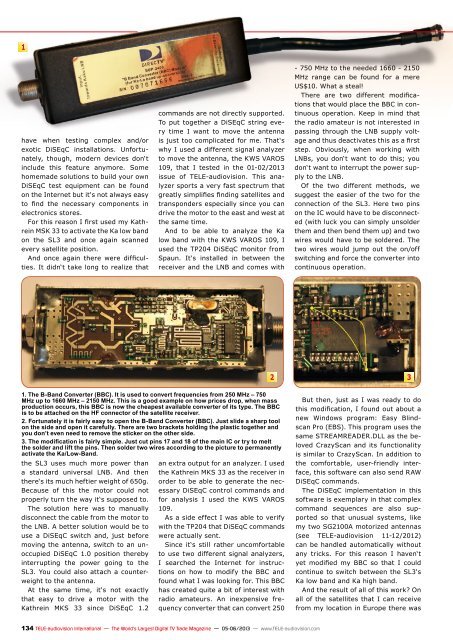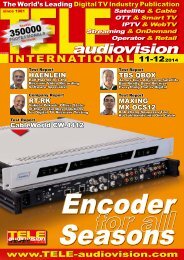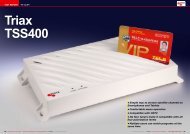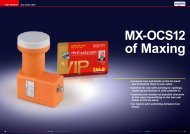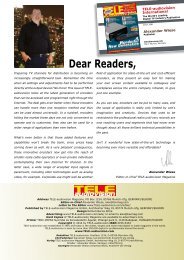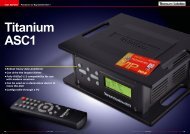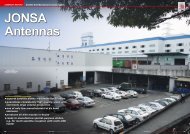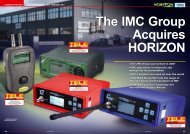eng TELE-audiovision 1305
The World’s Largest Digital TV Trade Magazine
The World’s Largest Digital TV Trade Magazine
You also want an ePaper? Increase the reach of your titles
YUMPU automatically turns print PDFs into web optimized ePapers that Google loves.
1<br />
have when testing complex and/or<br />
exotic DiSEqC installations. Unfortunately,<br />
though, modern devices don‘t<br />
include this feature anymore. Some<br />
homemade solutions to build your own<br />
DiSEqC test equipment can be found<br />
on the Internet but it‘s not always easy<br />
to find the necessary components in<br />
electronics stores.<br />
For this reason I first used my Kathrein<br />
MSK 33 to activate the Ka low band<br />
on the SL3 and once again scanned<br />
every satellite position.<br />
And once again there were difficulties.<br />
It didn‘t take long to realize that<br />
1. The B-Band converter (BBc). It is used to convert frequencies from 250 MHz – 750<br />
MHz up to 1660 MHz – 2150 MHz. This is a good example on how prices drop, when mass<br />
production occurs, this BBc is now the cheapest available converter of its type. The BBc<br />
is to be attached on the HF connector of the satellite receiver.<br />
2. Fortunately it is fairly easy to open the B-Band converter (BBc). Just slide a sharp tool<br />
on the side and open it carefully. There are two brackets holding the plastic together and<br />
you don’t even need to remove the sticker on the other side.<br />
3. The modification is fairly simple. Just cut pins 17 and 18 of the main IC or try to melt<br />
the solder and lift the pins. Then solder two wires according to the picture to permanently<br />
activate the Ka/Low-Band.<br />
the SL3 uses much more power than<br />
a standard universal LNB. And then<br />
there‘s its much heftier weight of 650g.<br />
Because of this the motor could not<br />
properly turn the way it‘s supposed to.<br />
The solution here was to manually<br />
disconnect the cable from the motor to<br />
the LNB. A better solution would be to<br />
use a DiSEqC switch and, just before<br />
moving the antenna, switch to an unoccupied<br />
DiSEqC 1.0 position thereby<br />
interrupting the power going to the<br />
SL3. You could also attach a counterweight<br />
to the antenna.<br />
At the same time, it‘s not exactly<br />
that easy to drive a motor with the<br />
Kathrein MKS 33 since DiSEqC 1.2<br />
commands are not directly supported.<br />
To put together a DiSEqC string every<br />
time I want to move the antenna<br />
is just too complicated for me. That‘s<br />
why I used a different signal analyzer<br />
to move the antenna, the KWS VAROS<br />
109, that I tested in the 01-02/2013<br />
issue of <strong>TELE</strong>-<strong>audiovision</strong>. This analyzer<br />
sports a very fast spectrum that<br />
greatly simplifies finding satellites and<br />
transponders especially since you can<br />
drive the motor to the east and west at<br />
the same time.<br />
And to be able to analyze the Ka<br />
low band with the KWS VAROS 109, I<br />
used the TP204 DiSEqC monitor from<br />
Spaun. It‘s installed in between the<br />
receiver and the LNB and comes with<br />
an extra output for an analyzer. I used<br />
the Kathrein MKS 33 as the receiver in<br />
order to be able to generate the necessary<br />
DiSEqC control commands and<br />
for analysis I used the KWS VAROS<br />
109.<br />
As a side effect I was able to verify<br />
with the TP204 that DiSEqC commands<br />
were actually sent.<br />
Since it‘s still rather uncomfortable<br />
to use two different signal analyzers,<br />
I searched the Internet for instructions<br />
on how to modify the BBC and<br />
found what I was looking for. This BBC<br />
has created quite a bit of interest with<br />
radio amateurs. An inexpensive frequency<br />
converter that can convert 250<br />
134 <strong>TELE</strong>-<strong>audiovision</strong> International — The World‘s Largest Digital TV Trade Magazine — 05-06/2013 — www.<strong>TELE</strong>-<strong>audiovision</strong>.com<br />
- 750 MHz to the needed 1660 - 2150<br />
MHz range can be found for a mere<br />
US$10. What a steal!<br />
There are two different modifications<br />
that would place the BBC in continuous<br />
operation. Keep in mind that<br />
the radio amateur is not interested in<br />
passing through the LNB supply voltage<br />
and thus deactivates this as a first<br />
step. Obviously, when working with<br />
LNBs, you don‘t want to do this; you<br />
don‘t want to interrupt the power supply<br />
to the LNB.<br />
Of the two different methods, we<br />
suggest the easier of the two for the<br />
connection of the SL3. Here two pins<br />
on the IC would have to be disconnected<br />
(with luck you can simply unsolder<br />
them and then bend them up) and two<br />
wires would have to be soldered. The<br />
two wires would jump out the on/off<br />
switching and force the converter into<br />
continuous operation.<br />
2 3<br />
But then, just as I was ready to do<br />
this modification, I found out about a<br />
new Windows program: Easy Blindscan<br />
Pro (EBS). This program uses the<br />
same STREAMREADER.DLL as the beloved<br />
CrazyScan and its functionality<br />
is similar to CrazyScan. In addition to<br />
the comfortable, user-friendly interface,<br />
this software can also send RAW<br />
DiSEqC commands.<br />
The DiSEqC implementation in this<br />
software is exemplary in that complex<br />
command sequences are also supported<br />
so that unusual systems, like<br />
my two SG2100A motorized antennas<br />
(see <strong>TELE</strong>-<strong>audiovision</strong> 11-12/2012)<br />
can be handled automatically without<br />
any tricks. For this reason I haven‘t<br />
yet modified my BBC so that I could<br />
continue to switch between the SL3‘s<br />
Ka low band and Ka high band.<br />
And the result of all of this work? On<br />
all of the satellites that I can receive<br />
from my location in Europe there was


